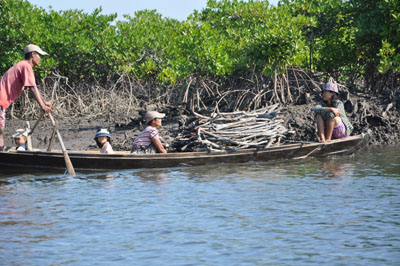Mangroves are disappearing worldwide. Burma, a country with some of the highest mangrove diversity, is no exception. This country once possessed the largest mangrove forests of the region, mostly in the Irrawaddy Delta, but as pointed out by The Irrawaddy on Dec. 4, the Delta’s mangrove forests shrank by 64.2 percent in 33-year period, with much of the area converted to small-scale rice farms.
Nearly 60 percent of the country’s total rice crop comes from the four regions that occupy the Irrawaddy River Delta and adjacent coastline. However, the expansion of rice cultivation in the Delta has come at a price, the rice ecosystems have been created by cutting and clearing the expanse of its mangrove forests.
Mangroves are salt-tolerant, evergreen forests. Their unique root systems blunt the force of strong waves, protecting inland areas from erosion and flooding. The diversity of rooting forms within their ecosystems also trap slit, creating a productive carbon-rich soil that has been demonstrated to hold carbon within it for long periods of time. Satellite images show how the clearing of the natural mangrove forests has left low-lying cropland and villages exposed to storms and cyclones. These exposed villages now pay a high price as evidenced by the impact of Cyclone Nargis in May 2008 and the human misery that it brought.
As the mangroves disappear, so does their biodiversity. Not only are mangroves home to a vast range of endangered species, they also provide shelter, critical for the survival of a host of fish, prawns, crabs etc. The estuarine fisheries, which support the non-farming population of the Delta, have been in steady decline, mirroring the decline of the mangroves.
Public awareness of the importance and value of mangroves has been identified as a critical factor in the conservation and restoration of these ecosystems. Thus Worldview Myanmar Limited, an NGO working together with Pathein and Myiek Universities, has begun a project to design and create “Mangrove Parks” to accomplish the goal of restoring and protecting the mangrove forests of Burma.
At Pathein University a mangrove area of 1,500 acres has been identified and at Myiek University an area of 778 acres has been identified. Work on the design of these parks has begun. Three professors and 27 students are in the process of developing baseline data. Home garden mangrove nurseries are already in production.
 The parks will be developed as field laboratories develop. Public visitation areas will be created with raised walkways or navigable waterways, which will allow visitors to experience the unique fauna and flora of Burma’s mangrove ecosystems. Myeik will focus on river-fed estuarine ecosystems and Pathien on an isolated coastal catchment without any riverine input.
The parks will be developed as field laboratories develop. Public visitation areas will be created with raised walkways or navigable waterways, which will allow visitors to experience the unique fauna and flora of Burma’s mangrove ecosystems. Myeik will focus on river-fed estuarine ecosystems and Pathien on an isolated coastal catchment without any riverine input.
The parks will also contain research facilities as well as observation and education facilities. Innovative planting methods that are analogous to the natural patterns rather than even aged monoculture plantations will be investigated. The project will promote scientific inquiry into the sustainable use of mangrove ecosystems.
Worldview Myanmar Limited has already identified and developed to the marketing stage a high quality, and health giving syrup from the Mangrove Palm, or Nypa fruticans. The project has been welcomed by the village of Kan Su near Pathein, where people are seeing the economic value of mangroves, other than for providing firewood.
The two mangrove parks will see the planting of up to 1 or 2 million mangrove trees as a national genetic resource. Here, seed and vegetative propagation techniques will be encouraged in order to maintain genetic breadth. While the value of carbon sequestration is well understood, measures of photosynthetic biomass have not been established.
The sea-level rise associated with climate change will impact coastal agriculture. These are the most vulnerable communities as rising salt levels preclude the growing of traditional crops. The Mangrove Palm has the potential to produce double the sugar quantity than an equal area of sugarcane and could be a boon for sugarcane or rice farmers in affected areas. The new parks will conduct research into new commercial uses for mangrove species.
Finally, the establishment of visitor friendly Mangrove Parks will create many sustainable economic opportunities for neighboring communities, reducing the impacts on the flora of the park. If well developed, Mangrove Parks will act not only as strong tourist attractions but also centers of public education on conservation and sustainable production.
Ranil Senanayake is a senior scientist and project director at Worldview Myanmar Limited.

















